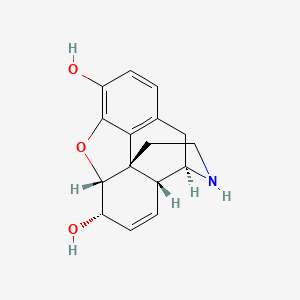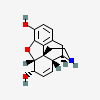Normorphine
- Normorphine
- Desmethylmorphine
- (-)-Normorphine
- N-Normorphine
- 466-97-7
- Create:2005-06-24
- Modify:2025-01-18

- (-)-normorphine
- (5alpha,6alpha)-7,8-didehydro-4,5-epoxymorphinan-3,6-diol hydrochloride
- 4,5-epoxy-3,6-dihydroxymorphin-7-ene
- desmethylmorphine
- morphinan-3,6alpha-diol, 7,8-didehydro-4,5alpha-epoxy-
- n-demethylmorphine
- normorphine
- normorphine hydrochloride
- normorphine perchlorate
- normorphine sulfamate
- Normorphine
- Desmethylmorphine
- (-)-Normorphine
- N-Normorphine
- 466-97-7
- N-Demethylmorphine
- Normorfina
- Normorphinum
- Demethylmorphine
- 4,5-Epoxy-3,6-dihydroxymorphin-7-ene
- DEA No. 9313
- UNII-XUI1Y24IMI
- XUI1Y24IMI
- Normorfina [INN-Spanish]
- Normorphinum [INN-Latin]
- Normorphine [INN:BAN:DCF]
- NSC 270042
- IDS-NN-008
- NORMORPHINE [MI]
- EINECS 207-381-4
- NORMORPHINE [INN]
- NSC-270042
- BRN 5297209
- CHEBI:7633
- Morphinan-3,6alpha-diol, 7,8-didehydro-4,5alpha-epoxy-
- Normorfina (INN-Spanish)
- Normorphinum (INN-Latin)
- 7,8-Didehydro-4,5alpha-epoxy-Morphinan-3,6alpha-diol
- Morphinan-3,6-alpha-diol, 7,8-didehydro-4,5-alpha-epoxy-
- Morphinan-3,6.alpha.-diol, 7,8-didehydro-4,5.alpha.-epoxy-
- Normorphine (1mg/ml in Methanol)
- Morphinan-3,6-diol, 7,8-didehydro-4,5-epoxy-, (5alpha,6alpha)-
- 4R,4aR,7S,7aR,12bS)-1,2,3,4,4a,7,7a,13-octahydro-4,12-methanobenzofuro[3,2-e]isoquinoline-7,9-diol
- (5alpha,6alpha)-7,8-Didehydro-4,5-epoxymorphinan-3,6-diol hydrochloride
- CHEMBL1227
- DTXCID6028945
- Normorphine (7,8-Didehydro-4,5alpha-epoxymorphinan-3,6alpha-diol)
- Morphinan-3,6-diol, 7,8-didehydro-4,5-epoxy-, (5.alpha.,6.alpha.)-
- (4R,4aR,7S,7aR,12bS)-1,2,3,4,4a,7,7a,13-octahydro-4,12-methanobenzofuro(3,2-e)isoquinoline-7,9-diol
- (4R,4aR,7S,7aR,12bS)-1,2,3,4,4a,7,7a,13-octahydro-4,12-methanobenzofuro[3,2-e]isoquinoline-7,9-diol
- 4R,4aR,7S,7aR,12bS)-1,2,3,4,4a,7,7a,13-octahydro-4,12-methanobenzofuro(3,2-e)isoquinoline-7,9-diol
- (5.ALPHA.,6.ALPHA.)-7,8-DIDEHYDRO-4,5-EPOXYMORPHINAN-3,6-DIOL HYDROCHLORIDE
- SCHEMBL26387
- GTPL1630
- Normorphine 1.0 mg/ml in Methanol
- Morphinan-3,6alpha-diol, 7,8-didehydro-4,5alpha-epoxy-(8CI)
- Morphinan-3,6-diol, 7,8-didehydro-4,5-epoxy-, (5alpha,6alpha)-(9CI)
147.06 Ų [M+H]+
165.78 Ų [M+Na]+
- Kidney
- Liver

H300 (97.4%): Fatal if swallowed [Danger Acute toxicity, oral]
H310 (97.4%): Fatal in contact with skin [Danger Acute toxicity, dermal]
H330 (97.4%): Fatal if inhaled [Danger Acute toxicity, inhalation]
P260, P262, P264, P270, P271, P280, P284, P301+P316, P302+P352, P304+P340, P316, P320, P321, P330, P361+P364, P403+P233, P405, and P501
(The corresponding statement to each P-code can be found at the GHS Classification page.)
Aggregated GHS information provided per 39 reports by companies from 2 notifications to the ECHA C&L Inventory. Each notification may be associated with multiple companies.
Information may vary between notifications depending on impurities, additives, and other factors. The percentage value in parenthesis indicates the notified classification ratio from companies that provide hazard codes. Only hazard codes with percentage values above 10% are shown.
Acute Tox. 2 (97.4%)
Acute Tox. 2 (97.4%)
Acute Tox. 2 (97.4%)
Patents are available for this chemical structure:
https://patentscope.wipo.int/search/en/result.jsf?inchikey=ONBWJWYUHXVEJS-ZTYRTETDSA-N
- CAS Common ChemistryLICENSEThe data from CAS Common Chemistry is provided under a CC-BY-NC 4.0 license, unless otherwise stated.https://creativecommons.org/licenses/by-nc/4.0/(-)-Normorphinehttps://commonchemistry.cas.org/detail?cas_rn=466-97-7
- ChemIDplusNormorphine [INN:BAN:DCF]https://pubchem.ncbi.nlm.nih.gov/substance/?source=chemidplus&sourceid=0000466977ChemIDplus Chemical Information Classificationhttps://pubchem.ncbi.nlm.nih.gov/source/ChemIDplus
- European Chemicals Agency (ECHA)LICENSEUse of the information, documents and data from the ECHA website is subject to the terms and conditions of this Legal Notice, and subject to other binding limitations provided for under applicable law, the information, documents and data made available on the ECHA website may be reproduced, distributed and/or used, totally or in part, for non-commercial purposes provided that ECHA is acknowledged as the source: "Source: European Chemicals Agency, http://echa.europa.eu/". Such acknowledgement must be included in each copy of the material. ECHA permits and encourages organisations and individuals to create links to the ECHA website under the following cumulative conditions: Links can only be made to webpages that provide a link to the Legal Notice page.https://echa.europa.eu/web/guest/legal-notice(5α,6α)-7,8-didehydro-4,5-epoxymorphinan-3,6-diol hydrochloridehttps://echa.europa.eu/substance-information/-/substanceinfo/100.020.140Normorphine (EC: 207-381-4)https://echa.europa.eu/information-on-chemicals/cl-inventory-database/-/discli/details/4007
- FDA Global Substance Registration System (GSRS)LICENSEUnless otherwise noted, the contents of the FDA website (www.fda.gov), both text and graphics, are not copyrighted. They are in the public domain and may be republished, reprinted and otherwise used freely by anyone without the need to obtain permission from FDA. Credit to the U.S. Food and Drug Administration as the source is appreciated but not required.https://www.fda.gov/about-fda/about-website/website-policies#linking
- Human Metabolome Database (HMDB)LICENSEHMDB is offered to the public as a freely available resource. Use and re-distribution of the data, in whole or in part, for commercial purposes requires explicit permission of the authors and explicit acknowledgment of the source material (HMDB) and the original publication (see the HMDB citing page). We ask that users who download significant portions of the database cite the HMDB paper in any resulting publications.http://www.hmdb.ca/citingNormorphinehttp://www.hmdb.ca/metabolites/HMDB0041959
- ChEBI
- Drug Enforcement Administration (DEA)LICENSEUnless otherwise indicated, information on Department of Justice websites is in the public domain and may be copied and distributed without permission. Citation of the Department of Justice as source of the information is appreciated, as appropriate.https://www.justice.gov/legalpoliciesDEA drug and chemical classificationhttps://www.dea.gov/drug-information/drug-scheduling
- LOTUS - the natural products occurrence databaseLICENSEThe code for LOTUS is released under the GNU General Public License v3.0.https://lotus.nprod.net/Normorphinehttps://www.wikidata.org/wiki/Q4327449LOTUS Treehttps://lotus.naturalproducts.net/
- ChEMBLLICENSEAccess to the web interface of ChEMBL is made under the EBI's Terms of Use (http://www.ebi.ac.uk/Information/termsofuse.html). The ChEMBL data is made available on a Creative Commons Attribution-Share Alike 3.0 Unported License (http://creativecommons.org/licenses/by-sa/3.0/).http://www.ebi.ac.uk/Information/termsofuse.htmlChEMBL Protein Target Treehttps://www.ebi.ac.uk/chembl/g/#browse/targets
- IUPAC Digitized pKa Dataset
- Comparative Toxicogenomics Database (CTD)LICENSEIt is to be used only for research and educational purposes. Any reproduction or use for commercial purpose is prohibited without the prior express written permission of NC State University.http://ctdbase.org/about/legal.jsp
- Drug Gene Interaction database (DGIdb)LICENSEThe data used in DGIdb is all open access and where possible made available as raw data dumps in the downloads section.http://www.dgidb.org/downloadsNORMORPHINEhttps://www.dgidb.org/drugs/ncit:C170234
- IUPHAR/BPS Guide to PHARMACOLOGYLICENSEThe Guide to PHARMACOLOGY database is licensed under the Open Data Commons Open Database License (ODbL) https://opendatacommons.org/licenses/odbl/. Its contents are licensed under a Creative Commons Attribution-ShareAlike 4.0 International License (http://creativecommons.org/licenses/by-sa/4.0/)https://www.guidetopharmacology.org/about.jsp#licenseGuide to Pharmacology Target Classificationhttps://www.guidetopharmacology.org/targets.jsp
- Therapeutic Target Database (TTD)
- Japan Chemical Substance Dictionary (Nikkaji)
- KEGGLICENSEAcademic users may freely use the KEGG website. Non-academic use of KEGG generally requires a commercial licensehttps://www.kegg.jp/kegg/legal.html
- Natural Product Activity and Species Source (NPASS)
- Metabolomics Workbench
- NCI Thesaurus (NCIt)LICENSEUnless otherwise indicated, all text within NCI products is free of copyright and may be reused without our permission. Credit the National Cancer Institute as the source.https://www.cancer.gov/policies/copyright-reuseNCI Thesaurushttps://ncit.nci.nih.gov
- NIST Mass Spectrometry Data CenterLICENSEData covered by the Standard Reference Data Act of 1968 as amended.https://www.nist.gov/srd/public-lawNormorphinehttp://www.nist.gov/srd/nist1a.cfm
- NORMAN Suspect List ExchangeLICENSEData: CC-BY 4.0; Code (hosted by ECI, LCSB): Artistic-2.0https://creativecommons.org/licenses/by/4.0/NormorphineNORMAN Suspect List Exchange Classificationhttps://www.norman-network.com/nds/SLE/
- PharosLICENSEData accessed from Pharos and TCRD is publicly available from the primary sources listed above. Please respect their individual licenses regarding proper use and redistribution.https://pharos.nih.gov/aboutnormorphinehttps://pharos.nih.gov/ligands/8USCBD6W6YPH
- SpectraBaseNormorphinehttps://spectrabase.com/spectrum/8FgzdrpdWnA
- Springer Nature
- Thieme ChemistryLICENSEThe Thieme Chemistry contribution within PubChem is provided under a CC-BY-NC-ND 4.0 license, unless otherwise stated.https://creativecommons.org/licenses/by-nc-nd/4.0/
- Wikidatanormorphinehttps://www.wikidata.org/wiki/Q4327449
- WikipediaDichlorobis(ethylenediamine)nickel(II)https://en.wikipedia.org/wiki/Dichlorobis(ethylenediamine)nickel(II)Normorphinehttps://en.wikipedia.org/wiki/Normorphine
- PubChem
- Medical Subject Headings (MeSH)LICENSEWorks produced by the U.S. government are not subject to copyright protection in the United States. Any such works found on National Library of Medicine (NLM) Web sites may be freely used or reproduced without permission in the U.S.https://www.nlm.nih.gov/copyright.htmlnormorphinehttps://www.ncbi.nlm.nih.gov/mesh/67010616
- GHS Classification (UNECE)GHS Classification Treehttp://www.unece.org/trans/danger/publi/ghs/ghs_welcome_e.html
- MolGenieMolGenie Organic Chemistry Ontologyhttps://github.com/MolGenie/ontology/
- PATENTSCOPE (WIPO)SID 388353379https://pubchem.ncbi.nlm.nih.gov/substance/388353379
- NCBI

